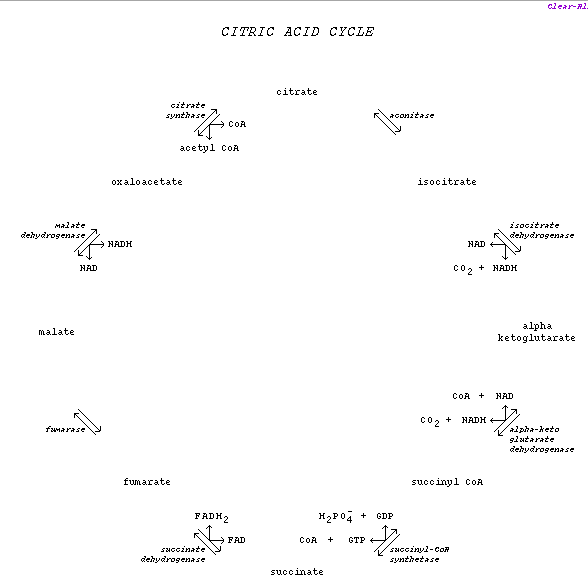Figure: Citric Acid Cycle
Jump to navigation
Jump to search
Biochemistry
- the citric acid cycle is the final common pathway for oxidation of fuel molecules
- most of the molecules enter the citric acid cycle as acetyl CoA formed via oxidative decarboxylation of pyruvate formed during glycolysis
- the citric acid cycle also provides intermediates for biosyntheses
- in eukaryotes, reactions of the citric acid cycle occur within the mitochondrial matrix.
- the 8 enzymatic reactions of the citric acid cycle produce 3 NADH & 1 FADH2 to feed 8 electrons into the electron transport chain
- citric acid cycle 1
- enzyme: citrate synthase
- substrates: oxaloacetate + acetyl-CoA
- products: citrate + Coenzyme-A
- citric acid cycle 2
- enzyme: aconitase-mt
- substrate: citrate
- product: isocitrate
- citric acid cycle 3
- enzyme: isocitrate dehydrogenase
- substrates: isocitrate + NAD+
- products: alpha-ketoglutarate + NADH + CO2
- citric acid cycle 4
- enzyme: alpha-ketoglutarate dehydrogenase
- substrates: alpha-ketoglutarate + NAD+ + coenzyme-A
- products: succinyl-CoA + CO2 + NADH
- citric acid cycle 5
- enzyme: succinyl-CoA synthetase
- substrates: succinyl-CoA + GDP + H2PO4-
- products: succinate + coenzyme-A + GTP
- citric acid cycle 6
- enzyme: succinate dehydrogenase
- substrates: succinate + flavin adenine dinucleotide
- products: fumarate + FADH2
- citric acid cycle 7
- enzyme: fumarase
- substrates: fumarate + H2O
- product: malate
- citric acid cycle 8
- enzyme: malate dehydrogenase
- substrates: malate + NAD+
- products: oxaloacetate + NADH
References
- ↑ Citrate cycle (TCA cycle) - Reference pathway Kyoto Encyclopedia of Gene & Genomes (KEGG) http://www.genome.ad.jp/kegg/pathway/map/map00020.html
- ↑ Wikipedia: Citric acid cycle https://en.wikipedia.org/wiki/Citric_acid_cycle
